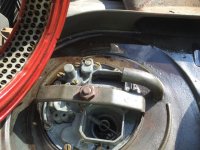Honolulu
Well-Known Member
Longish and sad.
Synched the carbs last weekend using my UniSyn and a homemade adaptor. Idle and about 2000 rpm okay. Tried out a bit of 1/8 inch tubing connected to the vacuum ports, with some ATF. Noticed the rear carb secondary drawing quite a bit of air at 2500, and that the synch previously set goes all to heck around 2500.
The car has been running hideous rich, exhaust reeks, so something's wrong.
I have been researching Benz Kjet (as used in BMW 320i also) and knew various 70's Benzes also used Zeniths. I came on the comment that the Zenith castings warp if tightened too much. I suspect that's what I've done. I have a "spare" pair of carbs from a 2800 sedan that have warped castings.
Now what to do?
1. Disassemble, try to straighten/sand the castings flat, then reinstall? Dunno if the warp can be ground out or if it's worth it.
2. Use that 528i Ljet head and injection system I've had sitting around for five-plus years? Injectors may be gummed up.
3. Strip the '87 735i which has a cracked windshield, a bit of rust, and failed AC, that I can't sell now and would be hard pressed to repair and break even on? Nice car when I drive it but no registration or insurance on it nowadays. Transfer injected motor and auto trans? Maybe better to keep the 5-speed and speedo connected.
4. Suck it in and buy 32/36s from somewhere, or if lucky, 38/38s, and linkage? I surely distrust used 32/36s since they wear badly at the throttle shafts - won't hold steady idle then. New seem about $250 per.
How say the multitude?
Anyone got some straight carbies laying about?
Synched the carbs last weekend using my UniSyn and a homemade adaptor. Idle and about 2000 rpm okay. Tried out a bit of 1/8 inch tubing connected to the vacuum ports, with some ATF. Noticed the rear carb secondary drawing quite a bit of air at 2500, and that the synch previously set goes all to heck around 2500.
The car has been running hideous rich, exhaust reeks, so something's wrong.
I have been researching Benz Kjet (as used in BMW 320i also) and knew various 70's Benzes also used Zeniths. I came on the comment that the Zenith castings warp if tightened too much. I suspect that's what I've done. I have a "spare" pair of carbs from a 2800 sedan that have warped castings.
Now what to do?
1. Disassemble, try to straighten/sand the castings flat, then reinstall? Dunno if the warp can be ground out or if it's worth it.
2. Use that 528i Ljet head and injection system I've had sitting around for five-plus years? Injectors may be gummed up.
3. Strip the '87 735i which has a cracked windshield, a bit of rust, and failed AC, that I can't sell now and would be hard pressed to repair and break even on? Nice car when I drive it but no registration or insurance on it nowadays. Transfer injected motor and auto trans? Maybe better to keep the 5-speed and speedo connected.
4. Suck it in and buy 32/36s from somewhere, or if lucky, 38/38s, and linkage? I surely distrust used 32/36s since they wear badly at the throttle shafts - won't hold steady idle then. New seem about $250 per.
How say the multitude?
Anyone got some straight carbies laying about?


